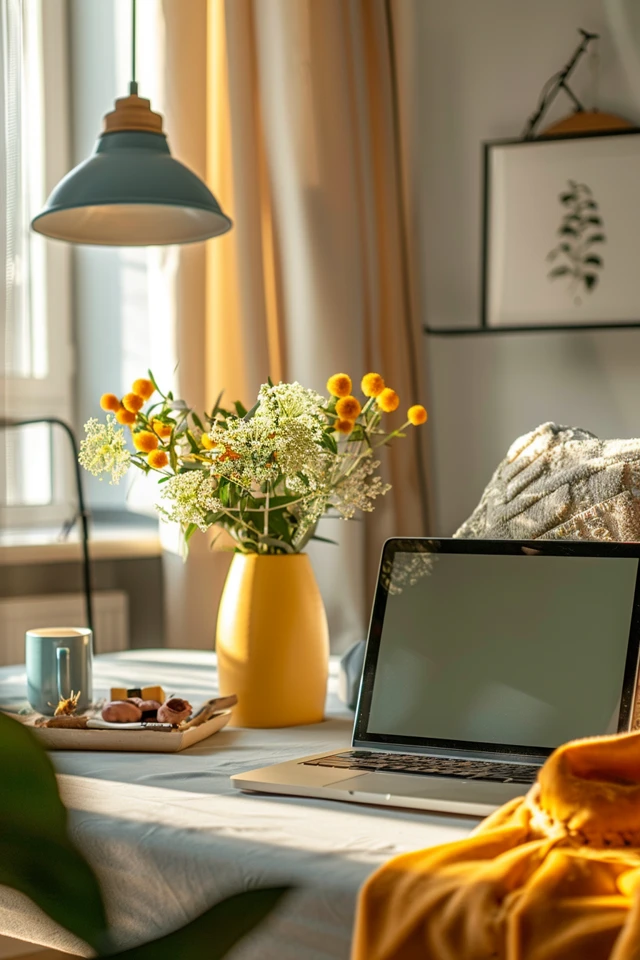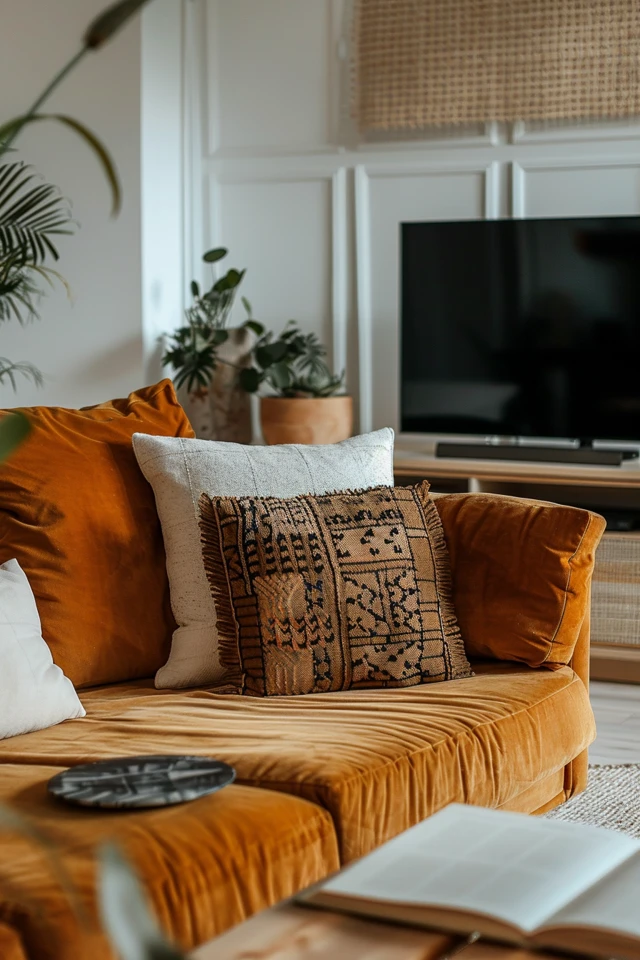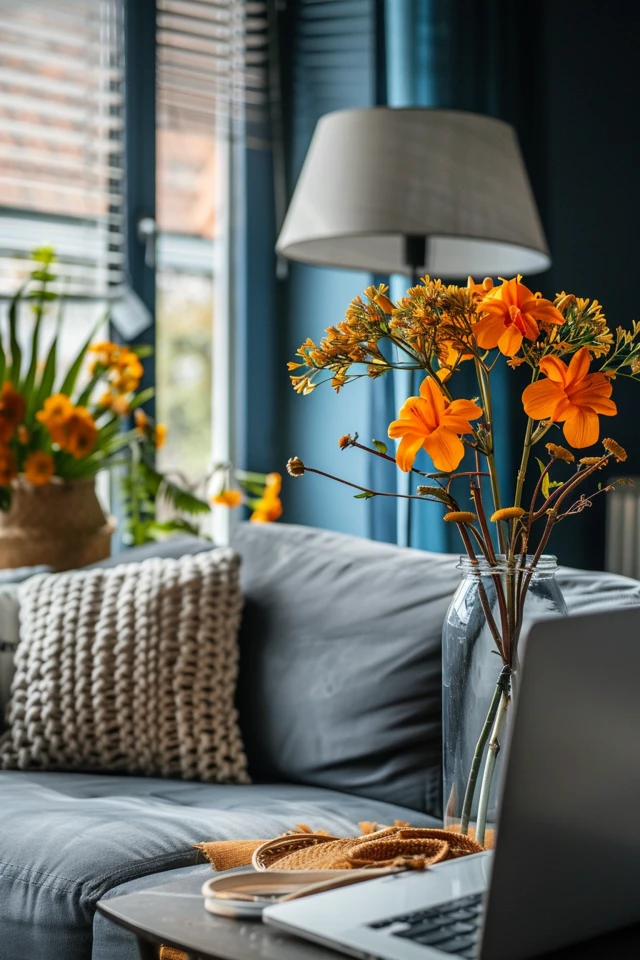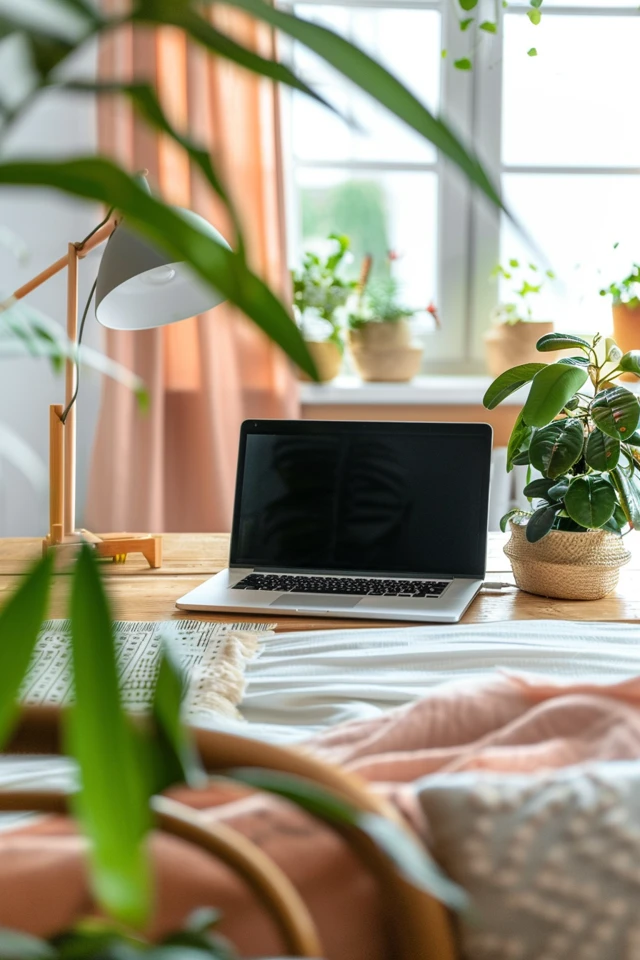Have you ever walked into a room and instantly felt a sense of peace and harmony? Maybe it was the carefully curated furniture arrangement, the perfectly chosen color palette, or the way each piece of decor seemed to tell a story. Whatever the reason, the power of a well-designed space is undeniable. It has the ability to transform not only the look and feel of a room but also the way we live and experience our surroundings.
As someone who has always been passionate about interior design, I’ve seen firsthand the impact it can make on our lives. From creating a cozy sanctuary to coming up with creative storage solutions in small apartments, the possibilities are endless. But I also understand that not everyone has the time, resources, or expertise to tackle an interior design project on their own.
That’s where online interior design comes in. With the rise of virtual interior design services, also known as e-design or remote interior decorating, transforming your space has never been easier or more accessible. Whether you’re looking for a complete room makeover or just need some guidance on how to spruce up your home, online interior design offers a convenient and cost-effective solution.
Imagine being able to collaborate with a professional interior designer from the comfort of your own home, no matter where you’re located. With just a few clicks, you can have personalized design recommendations, beautiful 3D renderings, and even a curated shopping list delivered right to your inbox. It’s like having your very own design team at your fingertips.
Whether you’re a busy professional with a hectic schedule, a new homeowner looking to make your mark, or someone who simply wants to refresh their living space, online interior design is the answer you’ve been searching for. It’s a game-changer that combines convenience, affordability, and professional expertise to help you create the home of your dreams.

Key Takeaways:
- Online interior design offers a convenient and cost-effective solution for transforming your space.
- Virtual interior design services provide personalized recommendations, 3D renderings, and curated shopping lists.
- Online interior design is accessible to anyone, no matter their location or schedule.
- It’s like having your own design team at your fingertips, ready to help you create the home of your dreams.
- Whether you’re a busy professional, a new homeowner, or someone looking to refresh their living space, online interior design can make your vision a reality.
Average Interior Designer Rates
When considering hiring an interior designer, it’s essential to understand the average rates in the industry. The cost of hiring an interior designer can vary depending on several factors, including the scope of the project, the designer’s experience level, and the location.
The average cost to hire an interior designer ranges from $2,000 to $12,000, excluding furniture. However, online interior design services offer a more budget-friendly option for those looking to enhance their spaces without breaking the bank. These services typically charge a flat rate per room, with costs ranging from $79 to $1,849.
I believe it’s important to mention that interior designers may also charge per hour. Rates can range from $50 to $500 per hour, depending on their level of experience. Junior designers might charge $50 per hour, while more experienced principal designers may charge anywhere from $200 to $500 per hour.
It’s important to note that these rates usually cover design and coordination services only, with separate charges for furniture and materials. On average, the cost for transforming a typical home with the help of an interior designer is around $5,000.
Why do interior designer rates vary?
Several factors contribute to the variation in interior designer rates. The designer’s experience and reputation play a significant role in determining their pricing. More experienced designers with a strong portfolio and positive client feedback often command higher rates.
Additionally, geographical location is an influential factor. Interior designer rates tend to be higher in urban areas due to the higher cost of living and increased demand for design services.
Lastly, the scope of the project and the size and function of the rooms involved can impact the overall cost. Larger homes or more complex projects require more time and resources, leading to higher rates.
Understanding the average rates of interior designers is essential when planning your project and budgeting for professional design services. By comparing different designers and carefully considering your needs, you can find the right interior designer who offers the services you require at a price that fits your budget.
Factors That Affect Interior Designer Costs
When it comes to hiring an interior designer, the cost can vary based on several factors that influence the overall price. Here are the key factors that determine interior designer costs:
Project Scope
The complexity and expertise required for a project will impact the cost of hiring an interior designer. Projects that involve extensive renovations or unique design challenges may require more time and resources, resulting in higher costs. On the other hand, smaller projects with less complexity may be more affordable.
Room Size and Function
The size and function of the room also play a role in determining the cost. Larger homes or rooms typically require more design work and materials, which can increase the overall cost. Additionally, specialized spaces such as kitchens or bathrooms may require additional expertise and resources, influencing the price.
Experience/Reputation of Designer
The experience and reputation of the interior designer can impact the price. Designers with a strong portfolio and established reputation may charge higher rates for their expertise. In contrast, less experienced designers or newcomers to the industry may offer more budget-friendly options.
Location
The location where the interior designer is based can also affect the cost. Interior design services in urban areas tend to be more expensive compared to rural regions. The cost of living, competition, and market demand all contribute to variations in pricing based on location.
By considering these factors, you can better understand the price range for hiring an interior designer and make an informed decision that aligns with your budget and vision for your space.
Case Study: The Impact of Location on Interior Design Costs
“In my experience as an interior designer, I’ve observed that location plays a significant role in determining interior design costs. For example, clients based in urban areas like New York City or Los Angeles can expect higher prices due to the high demand for design services and the increased cost of living. In contrast, clients in more rural areas often benefit from lower prices due to a less competitive market and lower operating costs. It’s important for clients to keep location in mind when budgeting for their design projects.”
Interior Designer Fee Structures
When it comes to determining their costs, interior designers use various fee structures that cater to different project requirements and client preferences. Let’s explore some popular billing strategies employed by interior designers:
Per Hour Rates
For smaller projects or consultations, interior designers often charge an hourly rate. The rates for per-hour billing can vary depending on the designer’s experience and expertise, ranging from $50 to $500 per hour. This method allows clients to pay for the exact amount of time invested in their project.
Flat Rates Per Room
Another common fee structure is the flat rate per room. Interior designers offer predetermined rates based on the type and size of the space. Flat rates per room typically range from $2,000 to $12,000, providing clients with a clear understanding of the cost involved for each individual room.

Commissions on Purchases
Some interior designers opt to charge commissions on purchases made during the project. This approach involves the designer receiving a percentage of the total cost of furniture and other items procured on behalf of the client. It incentivizes designers to source quality products while also ensuring transparency regarding the pricing involved.
Percentage of Project Cost
Another fee structure employed by interior designers is based on a percentage of the total project cost. Designers calculate their fees by taking a predetermined percentage, often ranging from 10% to 30%, of the overall budget. This method aligns the designer’s compensation directly with the scale and complexity of the project.
Cost-Plus Approach
The cost-plus method entails adding a markup percentage on top of the total cost of the project. The designer factors in all expenses, including materials, labor, and overhead, while also adding their fee. This approach ensures that the designer’s compensation is proportionate to the overall project cost but may require a more detailed breakdown of expenses for transparency.
Cost Per Square Foot
In some cases, interior designers may employ a cost-per-square-foot approach to determine their fees. The designers calculate the cost based on the square footage of the project, typically ranging from $5 to $17 per square foot. This method provides clients with an estimate based on the size of the space they want to design.
By offering these diverse fee structures, interior designers can accommodate a range of client preferences and project requirements, ensuring transparency and aligning their compensation with the value they provide.
Interior Design Cost Breakdown
When hiring an interior designer, it’s essential to understand the different elements that contribute to the overall cost. Let’s dive into the breakdown of interior design costs and the typical charges associated with them.
Consultation Fees
Consultation fees are an initial investment to meet with an interior designer and discuss your project. These fees usually range from $50 to $250 for a one-hour session. During this consultation, you can share your ideas, preferences, and budget with the designer, allowing them to understand your vision and provide initial recommendations.
Hourly Rates
Hourly rates are another component of interior design costs. The amount you can expect to pay per hour varies based on the designer’s experience level and expertise. Junior designers may charge around $50 per hour, while more experienced designers can command rates between $100 and $450 or more per hour. The hourly rate covers the time and effort the designer spends directly working on your project.
Square Footage Costs
For larger projects, interior designers may charge based on the square footage of the space being designed. Square footage costs typically range from $5 to $17 per square foot. This pricing method accounts for the size and complexity of the project and allows designers to allocate their time and resources accordingly.
Room-Based Costs
Depending on the scope of your project, interior designers may charge on a room-by-room basis. The costs associated with designing each room can range from $1,000 to $12,000 per room. Factors such as the size of the room, the level of customization required, and the complexity of the design can influence the pricing.
Purchase Fees
When an interior designer assists with selecting and purchasing furniture, accessories, and other design elements, they may charge a purchase fee. This fee is often a percentage added on top of the cost of the items being purchased. It compensates the designer for their time and expertise in curating the perfect pieces for your space.
By understanding the breakdown of interior design costs, including consultation fees, hourly rates, square footage costs, room-based costs, and purchase fees, you can have a clearer picture of the expenses associated with hiring an interior designer. This knowledge will help you budget effectively and make informed decisions while creating your dream space.
How Interior Designers Charge: Options and Payment Structures
When it comes to interior design services, there are various payment structures and fee options to consider. Understanding these payment structures will help you make an informed decision when hiring an interior designer. Let’s explore some of the common options and payment structures used by interior designers:

Retainers
Retainers are nonrefundable upfront deposits that clients pay to secure the services of an interior designer. Often, retainers are around 10% of the total project cost. This payment structure allows designers to allocate time specifically for your project and get started on the design process.
Design Fee Installments
Design fee installments involve dividing the design fee into multiple payments based on the progress of the project. This payment structure allows clients to manage their budget and make payments at different stages of the design process. It provides flexibility and ensures that you are satisfied with each phase of the project before making a complete payment.
Product Deposits
Interior designers may require product deposits for furnishings and materials that they will purchase on your behalf. This ensures that the designer has the necessary funds to initiate purchases and secure items for your project. Product deposits are typically separate from the design fee and are based on the cost of the specific items being purchased.
Fixed Rates
Fixed rates are a flat fee charged by interior designers for the entire project. This payment structure is suitable for clients who prefer knowing upfront how much they will be paying for the design services. Fixed rates are determined based on the complexity and scope of the project, taking into account factors such as square footage, room type, and the desired level of design expertise.
Cost Plus
Cost plus is a payment structure where interior designers incorporate a markup on top of the total cost of materials and furnishings used for your project. This approach allows designers to charge a percentage fee based on the actual expenses incurred. The cost-plus method is transparent, as it clearly shows the cost of each item and the markup charged by the designer.
Understanding the different payment structures and fee options used by interior designers will help you choose the most suitable arrangement for your project. Whether you prefer the flexibility of design fee installments, the transparency of a fixed rate, or the clarity of cost-plus, discussing these options with your designer will ensure a smooth payment process. Remember, each payment structure offers its own advantages, so finding the one that aligns with your budget and preferences is key.
Conclusion
In conclusion, hiring an interior designer can be a game-changer when it comes to creating a beautifully designed space that reflects your style and fits your budget. Whether you opt for traditional face-to-face services or explore the convenience of online interior design, the choice is yours.
As we have discussed throughout this article, the cost of hiring an interior designer depends on several factors, including the scope of your project, the size and function of the rooms involved, the experience of the designer, and even the location. By understanding these variables, you can better estimate and plan for the expenses involved in your design journey.
Moreover, being aware of the different fee structures and payment options available will empower you to make an informed decision. Whether you prefer retainers, design fee installments, product deposits, fixed rates, or cost-plus fees, you can select the payment structure that suits your needs and preferences.
Ultimately, by understanding the costs and options associated with hiring an interior designer, you can embark on your design project with confidence, knowing that you’re making the most of your investment. So go ahead and create your dream space without breaking the bank!
FAQ
What is online interior design?
Online interior design, also known as virtual interior design or e-design services, is a convenient and cost-effective way to work with an interior designer remotely. Through digital platforms, you can receive design advice, personalized recommendations, and a complete design plan for your space.
How much does it cost to hire an interior designer?
The average cost to hire an interior designer ranges from ,000 to ,000, excluding furniture. Online interior design services offer a more budget-friendly option, with costs ranging from to
FAQ
What is online interior design?
Online interior design, also known as virtual interior design or e-design services, is a convenient and cost-effective way to work with an interior designer remotely. Through digital platforms, you can receive design advice, personalized recommendations, and a complete design plan for your space.
How much does it cost to hire an interior designer?
The average cost to hire an interior designer ranges from $2,000 to $12,000, excluding furniture. Online interior design services offer a more budget-friendly option, with costs ranging from $79 to $1,849 for a flat rate per room. Hourly rates for interior designers vary from $50 to $500, depending on their experience level and location.
What factors affect the cost of hiring an interior designer?
Several factors influence the cost of hiring an interior designer. These include the project scope, room size and function, experience/reputation of the designer, and location. Interior design costs are typically higher in urban areas compared to rural regions.
What are the fee structures used by interior designers?
Interior designers use various fee structures to determine their costs. These may include per hour rates, flat rates per room, commissions on purchases, or a percentage of the project cost. Costs can also be calculated based on the square footage of the project.
How is the cost of interior design broken down?
The cost to hire an interior designer includes various elements such as consultation fees, hourly rates, square footage costs, room-based costs, and purchase fees. Consultation fees range from $50 to $250 for an initial one-hour session. Hourly rates range from $50 to $450 or more, depending on the designer’s experience level. Square footage costs range from $5 to $17 per square foot, while room-based costs can range from $1,000 to $12,000 per room. Purchase fees are often a percentage added on top of the cost of items like furniture and accessories.
What are the payment options when hiring an interior designer?
Interior designers have different payment structures, including retainers, design fee installments, product deposits, fixed rates, and cost-plus fees. Retainers are nonrefundable upfront deposits, usually around 10% of the total project cost. Design fee installments can be divided into multiple payments based on the progress of the project. Product deposits may be required for furnishings that the designer will purchase. Fixed rates are a flat fee for the entire project, while cost-plus fees include a markup on top of the total cost of materials and furnishings.
What are the benefits of hiring an interior designer?
Hiring an interior designer can help you create a beautifully designed space that suits your style and budget. They have the expertise to optimize your space and make it functional and visually appealing. Whether you opt for traditional or online interior design services, their guidance can save you time and money while ensuring a professional result.
,849 for a flat rate per room. Hourly rates for interior designers vary from to 0, depending on their experience level and location.
What factors affect the cost of hiring an interior designer?
Several factors influence the cost of hiring an interior designer. These include the project scope, room size and function, experience/reputation of the designer, and location. Interior design costs are typically higher in urban areas compared to rural regions.
What are the fee structures used by interior designers?
Interior designers use various fee structures to determine their costs. These may include per hour rates, flat rates per room, commissions on purchases, or a percentage of the project cost. Costs can also be calculated based on the square footage of the project.
How is the cost of interior design broken down?
The cost to hire an interior designer includes various elements such as consultation fees, hourly rates, square footage costs, room-based costs, and purchase fees. Consultation fees range from to 0 for an initial one-hour session. Hourly rates range from to 0 or more, depending on the designer’s experience level. Square footage costs range from to per square foot, while room-based costs can range from
FAQ
What is online interior design?
Online interior design, also known as virtual interior design or e-design services, is a convenient and cost-effective way to work with an interior designer remotely. Through digital platforms, you can receive design advice, personalized recommendations, and a complete design plan for your space.
How much does it cost to hire an interior designer?
The average cost to hire an interior designer ranges from $2,000 to $12,000, excluding furniture. Online interior design services offer a more budget-friendly option, with costs ranging from $79 to $1,849 for a flat rate per room. Hourly rates for interior designers vary from $50 to $500, depending on their experience level and location.
What factors affect the cost of hiring an interior designer?
Several factors influence the cost of hiring an interior designer. These include the project scope, room size and function, experience/reputation of the designer, and location. Interior design costs are typically higher in urban areas compared to rural regions.
What are the fee structures used by interior designers?
Interior designers use various fee structures to determine their costs. These may include per hour rates, flat rates per room, commissions on purchases, or a percentage of the project cost. Costs can also be calculated based on the square footage of the project.
How is the cost of interior design broken down?
The cost to hire an interior designer includes various elements such as consultation fees, hourly rates, square footage costs, room-based costs, and purchase fees. Consultation fees range from $50 to $250 for an initial one-hour session. Hourly rates range from $50 to $450 or more, depending on the designer’s experience level. Square footage costs range from $5 to $17 per square foot, while room-based costs can range from $1,000 to $12,000 per room. Purchase fees are often a percentage added on top of the cost of items like furniture and accessories.
What are the payment options when hiring an interior designer?
Interior designers have different payment structures, including retainers, design fee installments, product deposits, fixed rates, and cost-plus fees. Retainers are nonrefundable upfront deposits, usually around 10% of the total project cost. Design fee installments can be divided into multiple payments based on the progress of the project. Product deposits may be required for furnishings that the designer will purchase. Fixed rates are a flat fee for the entire project, while cost-plus fees include a markup on top of the total cost of materials and furnishings.
What are the benefits of hiring an interior designer?
Hiring an interior designer can help you create a beautifully designed space that suits your style and budget. They have the expertise to optimize your space and make it functional and visually appealing. Whether you opt for traditional or online interior design services, their guidance can save you time and money while ensuring a professional result.
,000 to ,000 per room. Purchase fees are often a percentage added on top of the cost of items like furniture and accessories.
What are the payment options when hiring an interior designer?
Interior designers have different payment structures, including retainers, design fee installments, product deposits, fixed rates, and cost-plus fees. Retainers are nonrefundable upfront deposits, usually around 10% of the total project cost. Design fee installments can be divided into multiple payments based on the progress of the project. Product deposits may be required for furnishings that the designer will purchase. Fixed rates are a flat fee for the entire project, while cost-plus fees include a markup on top of the total cost of materials and furnishings.
What are the benefits of hiring an interior designer?
Hiring an interior designer can help you create a beautifully designed space that suits your style and budget. They have the expertise to optimize your space and make it functional and visually appealing. Whether you opt for traditional or online interior design services, their guidance can save you time and money while ensuring a professional result.

